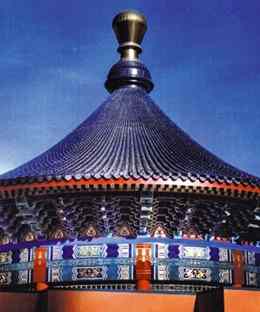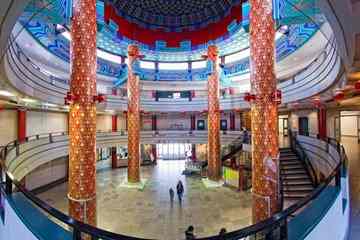A bowl that sings. An earthquake detector that's nearly 2,000 years old. A painting made entirely from feathers.
 These are just a few of the unusual items one can find in the Calgary Chinese Cultural Centre's museum, hidden away in the centre's basement.
These are just a few of the unusual items one can find in the Calgary Chinese Cultural Centre's museum, hidden away in the centre's basement.
It's a small, but interesting, treasure trove of cultural and historical artifacts. As the cultural centre's executive administrator, Samantha Yang, says, "It's not a museum quite like the Glenbow. I like to call it a showcase of Chinese culture," adding that most of the museum's traffic comes from school groups and tourists.
At the bottom of the long set of stairs winding into the centre's depths, two lion statues greet you.
"Lions are like guardian angels in Western culture," Yang explains, adding that you shouldn't confuse Chinese lions with the British ones ornamenting Centre Street Bridge, which are actually modelled after those in London's Trafalgar Square.
Yang says Chinese lions always come in male and female pairings, with the male resting his paw on a ball, and the female resting hers on a cub. Oh yes, and always look for the female to the right of the male because, as Yang says, "The woman is always right!"
This is just one of the cultural tidbits you can pick up visiting the Chinese Cultural Centre's museum.
Just around the corner from the lions is the museum's most well-known exhibit: several life-size replicas of China's famed terracotta soldiers, accompanied by a chariot and horses.
 Yang says Calgary is the only place in Canada to have a display of this kind, which the centre purchased from the Chinese government after it was shown at Expo 86 in Vancouver.
Yang says Calgary is the only place in Canada to have a display of this kind, which the centre purchased from the Chinese government after it was shown at Expo 86 in Vancouver.
After the Glenbow Museum's recent announcement that they have had to cancel the Terracotta Army exhibit they had scheduled for next year, because China decided to recall its artifacts, the Calgary Chinese Cultural Centre's museum will remain the only place, locally, to get a taste of this fascinating archaeological find.
Several photos accompany the display, explaining the history behind -- and excavation of -- the 8,000 terracotta warriors, horses and chariots that were buried some 2,200-years ago, in the tomb of Qin Shi Huang, China's first emperor.
Across from the warriors sits an impressive set of ornately-carved, mahogany furniture with real marble inlays, in the style of the Qing Dynasty, China's last ruling dynasty. "It looks good, but it's not very comfortable," Yang laughs.
A family from Hong Kong donated the set. Yang says that's the case with most of the Museum's exhibits: donations solicited before the Cultural Centre's opening in 1992. She says they have exceeded the room available to display them, so some items, like a 60-piece collection of traditional embroidery, are stashed away, awaiting their turn for public exhibition.
As the Museum doesn't have sufficient funding for its own curator, Yang says exhibits are relatively static at this point, something she says the Centre hopes to change in the future.
Down from the furniture, two glass display cases line the walls, each filled with colourful plates, vases and Shiwan clayware sculptures that depict Chinese characters from daily life and legend. You have to take time to examine each piece to appreciate the intricacy of the work involved.
Sharing the display cases are artifacts representing China's four great inventions: gunpowder, papermaking, printing, and the magnetic compass.
In front of the cases, sits a large, bronze-coloured urn. Three-dimensional, carved dragons snake down the urn's surface, each bearing a ball in its mouth. Surrounding the urn are a bunch of toads.
This unusual and striking creation, a replica of something made some 1800-years ago, is not a ceremonial vase for cremated remains, or a fancy vessel for storing water. In fact, it's an early form of earthquake detector. Who knew?!
The Museum's most in-depth exhibit belongs to Our Chosen Land, a display examining Chinese immigration to Canada from 1858 onward, including such artifacts as a Chinese Head-Tax Certificate, a sobering reminder of the discrimination they faced not so long ago.
A number of photos of Chinatown's early days punctuate the exhibit, along with items like old cash registers and wash basins that reflect the early employment of Chinese immigrants in laundromats and restaurants. Yang says the Cultural Centre is contemplating expanding this display to make it the focus of the Museum as a whole, especially in light of Chinatown's Centennial.
"We'd like to give people a bit more of an in-depth look at Chinese-Canadians," she says.
Rounding out the Museum's exhibits are a couple of other items Yang says earn rave reviews from students and tourists alike: the "Bronze Singing Fish Basin" and a three-dimensional painting made entirely from bird feathers. The bowl actually seems to sing -- and the water inside, dance -- when you rub it a certain way with wet hands.
Glancing through the guest book near the Museum's entrance, one finds evidence of visitors from all over the world, ranging from Trinidad and Tobago, to Bolivia, to Wales. One person calls the Museum "a downtown treasure," while another writes, "It has been a privilege to see the wonderful craftsmanship and the inspiring history of the Chinese people." And, of course, leave it to a kid to write, "It was cool!"
Author: Kathleen Renne | Source: The Calgary Herald © [October 07, 2010]